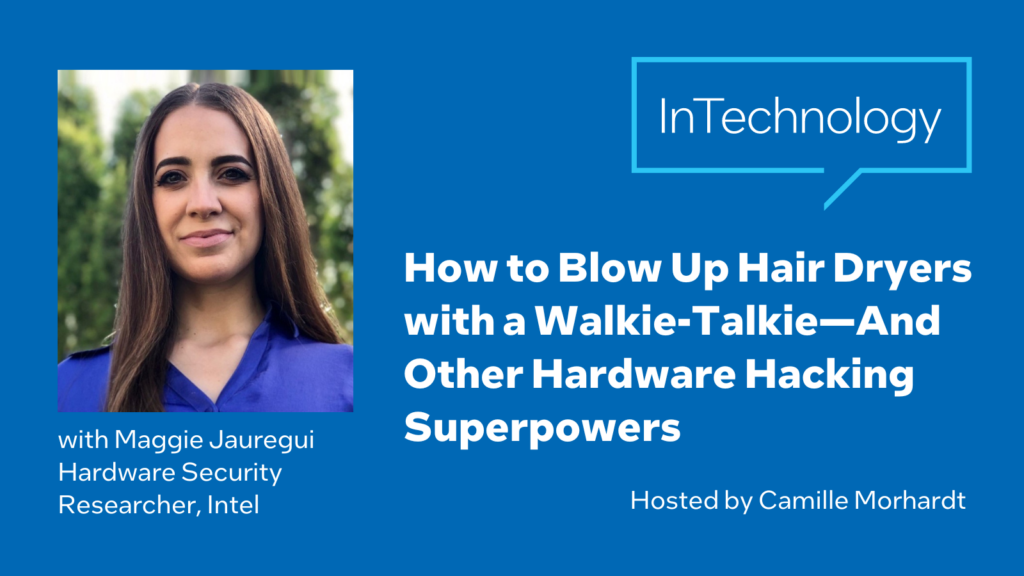In this episode of InTechnology, Camille gets into endpoint vulnerability management beneath the OS with Intel® Device Heath with guest Novin Kaihani, Senior Director and GM of Client Software Products at Intel. The conversation covers why finding endpoint vulnerabilities at the OS level and below can be so challenging, along with a quick overview of how the endpoint vulnerability management product works.
About Intel® Device Heath:
Today’s organizations often lack complete visibility into the health and security of their PCs, especially below-the-OS. Typical PC scans focus on vulnerabilities found in OS and applications levels. Few have the expertise to decode areas of vulnerability in the firmware and hardware levels, yet this where attacks can be catastrophic. Intel Device Health is a cloud service that uses telemetry at the firmware and hardware levels to complete the picture of a PC’s overall risk from vulnerability. To learn more about implementing Intel Device Health throughout your fleet, connect with an Intel, VMware, or Eclypsium sales rep.
To find the transcription of this podcast, scroll to the bottom of the page.
To find more episodes of InTechnology, visit our homepage. To read more about cybersecurity, sustainability, and technology topics, visit our blog.
The views and opinions expressed are those of the guests and author and do not necessarily reflect the official policy or position of Intel Corporation.
Follow our host Camille @morhardt.
Learn more about Intel Cybersecurity and the Intel Compute Life Cycle (CLA).
Cybersecurity Challenges at the OS Level and Below
Novin explains that while there is plenty of security coverage for application OS vulnerabilities, there isn’t nearly enough coverage at the OS level and below. This is due to difficulties that come from identifying vulnerabilities with firmware, microcode, drivers, and many other complex issues. That’s where he says Intel and Eclypsium have partnered on Intel® Device Heath as a solution for endpoint security as a way to fill in that gap in the market and improve customer security. The Intel side identifies security vulnerabilities below the OS and highlights them to Eclypsium, whose product then verifies identification and either patches or remediates the found vulnerabilities.
How Endpoint Vulnerability Management Works
Camille and Novin then dive into how Intel® Device Heath works. Novin details how vulnerabilities below the OS are found at the OS level. The steps of the process are simple—scan platform data, compare it to a vulnerability database, and then notify the discovered vulnerabilities to companies like Eclypisum to then be remediated. However, the challenge comes from identifying the vulnerabilities out in the wild rather than in a controlled lab setting. There are many catalogs of vulnerabilities, but identifying correctly between known vulnerabilities and the specific endpoint is the most challenging part. Novin explains how a team of engineers mostly manually cross-checks, with some automated assistance. Ultimately, this type of endpoint vulnerability management is designed for IT organizations and businesses of any size. The best part is it provides a seamless experience by being built into the security products businesses already have, not requiring a separate download or installation.
Novin Kaihani, Senior Director and General Manager of Client Software Products at Intel

Novin has been Senior Director and GM of Client Software Products at Intel since 2021. He started his career at Intel from 2004-2007 as a Network Engineer, and he has steadily been with the company since 2008. Some of Novin’s previous positions at Intel include Director and Chief of Staff & Technical Advisor for the Commercial Client Group as well as Director of Product Management & Business Strategy for the Data Center Group. He is a Cisco Certified Network Associate and has a degree in finance from Portland State University.



